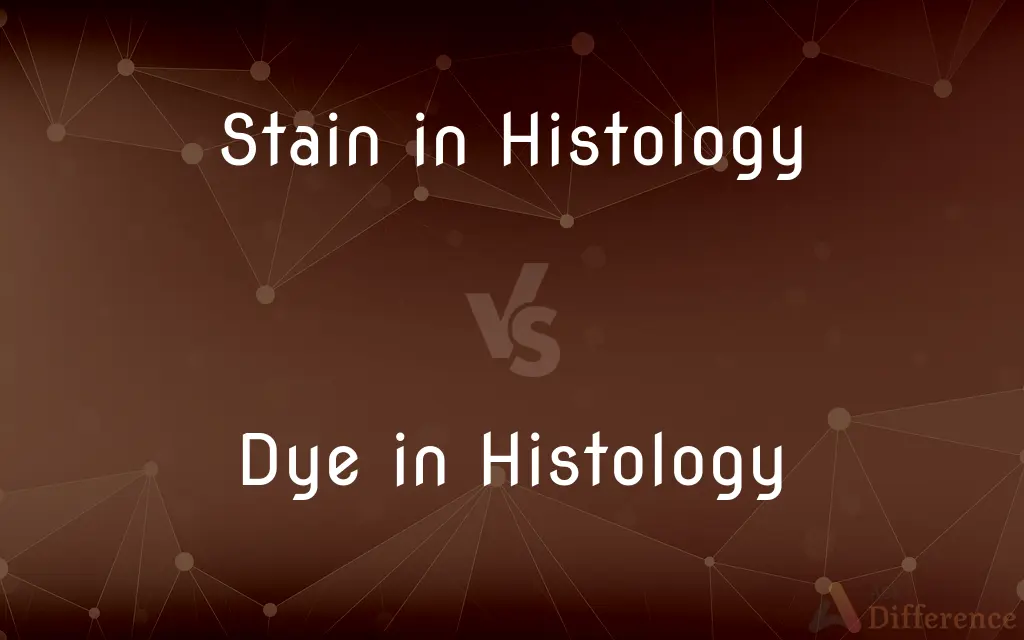Stain in Histology vs. Dye in Histology — What's the Difference?
Edited by Tayyaba Rehman — By Fiza Rafique — Published on December 29, 2023
In histology, a stain enhances tissue contrast for microscopy, while a dye provides the color for these stains.

Difference Between Stain in Histology and Dye in Histology
Table of Contents
ADVERTISEMENT
Key Differences
In the field of histology, the term "stain" refers to a substance used to enhance the contrast of biological tissues under a microscope. On the other hand, a "dye" in histology represents the actual colored substance that makes staining possible. The differentiation between the two may seem subtle, but it holds significance in laboratory practices.
Stains in histology play a crucial role in allowing scientists and researchers to observe, identify, and differentiate microscopic structures within tissues. These stains work by binding to specific components within the tissue. In contrast, dyes in histology are often the key ingredients within these stains, providing the color that binds to tissue components.
The process of staining involves applying a dye (or combination of dyes) in a specific manner to highlight particular elements within a tissue sample. Therefore, while all stains in histology will use dyes, not all dyes can necessarily be used as stains. The efficacy of a dye as a stain in histology depends on its binding properties and the specificity it offers.
One might consider a stain in histology as the final product, which often consists of multiple components, including dyes, mordants, and other chemicals that work together to highlight tissue structures. Conversely, a dye in histology is a singular component, a colored substance that, when used appropriately, can serve as part of a stain.
In essence, the difference between a stain and a dye in histology lies in their application and composition. Stains are the tools used to visualize tissue details, and dyes are the colored molecules that give these tools their functionality.
ADVERTISEMENT
Comparison Chart
Definition
A substance enhancing tissue contrast
Colored substance providing color to stains
Application
Used to observe tissue structures
Provides color to stain preparations
Composition
May contain multiple components (dyes, mordants, etc.)
Singular colored substance
Specificity
Binds to specific tissue components
Depends on its chemical properties for binding
Role
Visualization tool in microscopy
Coloring agent in stains
Compare with Definitions
Stain in Histology
A substance used to highlight microscopic tissue structures.
Hematoxylin and eosin stain in histology is commonly used to examine tissue morphology.
Dye in Histology
A pigment providing color to histological stains.
The chosen dye in histology can greatly influence the stain's specificity.
Stain in Histology
A tool aiding in tissue differentiation and observation.
The stain in histology provided clarity, revealing the presence of abnormal cells.
Dye in Histology
A molecule binding to tissue components to reveal them.
This dye in histology has a strong affinity for acidic cellular elements.
Stain in Histology
An agent enhancing contrast under a microscope.
Without the right stain in histology, cellular details can remain hidden.
Dye in Histology
A colored substance employed in staining processes.
The dye in histology illuminated the cell nuclei, making them easily distinguishable.
Stain in Histology
A solution applied to tissue samples for microscopy.
Selecting the appropriate stain in histology is pivotal for accurate diagnosis.
Dye in Histology
A chemical agent giving hue to stain preparations.
The intensity of the dye in histology dictates the vividness of the stained sample.
Stain in Histology
A preparation for visualizing specific cellular components.
Special stains in histology help identify certain pathogens within tissue samples.
Dye in Histology
A colored component used in microscopy studies.
Without the correct dye in histology, the stain would lack its defining color.
Common Curiosities
What is a stain in histology?
It's a substance applied to tissue samples to enhance contrast for microscopic observation.
How does a dye in histology differ from a stain?
A dye provides the color, while a stain uses the dye to highlight tissue structures.
Can any dye be used as a stain in histology?
Not necessarily. A dye's effectiveness as a stain depends on its binding properties and specificity.
What happens if an incorrect dye is used in a histological stain?
It may not bind appropriately, resulting in poor or misleading visualization.
Why are stains in histology important?
They allow scientists to differentiate, identify, and observe microscopic tissue structures.
Is a stain in histology always composed of just one dye?
No, some stains can contain multiple dyes, mordants, and other chemicals.
How do researchers choose a specific stain in histology?
It's based on the tissue type and the specific cellular components they wish to observe.
Does every dye in histology bind to all tissue types?
No, dyes have specific chemical properties that determine their binding affinities.
Why are some stains in histology named after specific colors?
They're often named after the primary dye used or the color they impart to specific tissue components.
Do all dyes in histology have the same intensity?
No, the intensity and hue vary depending on the dye's chemical makeup.
What's the role of a dye in histology?
It provides the color to the stains, enabling visualization of tissue components.
Are there stains in histology that don't use dyes?
Generally, stains utilize dyes for color, but other components like mordants can influence staining properties.
Can a single tissue sample be stained multiple times using different stains in histology?
Yes, depending on the research goal, sequential staining can be employed.
Is the use of a stain in histology limited to specific research areas?
While commonly used in medical research, stains are also utilized in botany, zoology, and other fields to study microscopic structures.
How many types of dyes in histology exist?
Numerous, each with unique properties to highlight different cellular structures or components.
Share Your Discovery

Previous Comparison
Dugongs vs. Manatees
Next Comparison
Dork vs. DweebAuthor Spotlight
Written by
Fiza RafiqueFiza Rafique is a skilled content writer at AskDifference.com, where she meticulously refines and enhances written pieces. Drawing from her vast editorial expertise, Fiza ensures clarity, accuracy, and precision in every article. Passionate about language, she continually seeks to elevate the quality of content for readers worldwide.
Edited by
Tayyaba RehmanTayyaba Rehman is a distinguished writer, currently serving as a primary contributor to askdifference.com. As a researcher in semantics and etymology, Tayyaba's passion for the complexity of languages and their distinctions has found a perfect home on the platform. Tayyaba delves into the intricacies of language, distinguishing between commonly confused words and phrases, thereby providing clarity for readers worldwide.












































